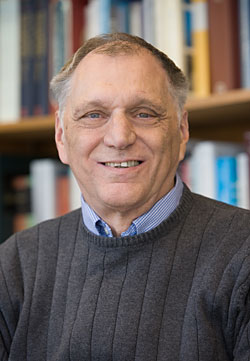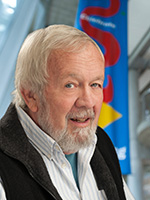History of the UCSD Neurosciences Graduate Program
The University of California established the San Diego campus in 1959 and UCSD campus construction began in 1960. The first undergraduate class (of 181 students) entered in 1964. The School of Medicine was established in 1962 and the first medical school class (of 47 students) enrolled in 1968. Dr. Robert Livingston was recruited to UCSD in 1965 as the founding Chair of the Neurosciences Department. Instead of having a classical Neurology Department, UCSD established one of the first Neurosciences Departments in the country as a mix of basic and clinical research. He recruited two additional senior faculty members. Dr. Theodore Bullock, the founding father of the field of neuroethology, arrived from UCLA in 1966. Dr. Robert Galambos, renowned for his studies of bat echolocation and challenged for promoting the importance of glia, was recruited from Walter Reed Research Institute in 1968. One of his first actions was to establish the UCSD Neurosciences Graduate Program, which took its first students in 1969.
This triumvirate believed strongly in the interdisciplinary approach to neuroscience, which spilled over into the Neurosciences Graduate Program. They were influenced by the organization of the Neurosciences Research Program, that had been established by Francis Schmitt at the Rockefeller Institute (now University). Schmitt organized meetings, developed reports and organized books that included molecular biologists, electrophysiologists, anatomists, pharmacologists, biochemists, modelers and clinicians, with a “Let all the flowers bloom” approach. Livingston, Bullock, and Galambos completely bought into the notion that the best way to make progress was through collaboration—both formal and informal—at all levels of interest and expertise. This broad-net, everybody-in-the-boat approach was a guiding principle in setting up the Neurosciences Graduate Program. The Program established an approach that was inclusive along many axes: clinical/basic, campus/medical school, vertebrate/invertebrate research animals. They reached out to the local institutions (Salk Institute for Biological Studies, The Scripps Research Institute, Scripps Institution of Oceanography) to make all the faculty members in the area part of this new graduate program.
In a seminal decision, the founders insisted that all faculty members have equal access to the first major training grant that they received, from the Sloan Foundation, in 1971. Bob Livingston from Neurosciences, Jon Singer from Biology, and Sam Barondes from Psychiatry were the Prinicipal Investigators. This collaborative, interactive, interdisciplinary spirit has been retained over the years, even as the number of neuroscientists in the community grew significantly. Early students included Peter Hartline, Doug Eaton, Eric Courchesne, Eric Knudsen, Otto Friesen, and Jonathan Raper. In the early 1990s, the National Academy of Science decided to rank-order graduate programs in the USA. Remarkably, UCSD’s Neuroscience Graduate Program came in #1 in 1995! To maintain this premier status the program instituted numerous features - its core curriculum (NEU 200A/B/C), reading courses, Boot Camp, a yearly Retreat, a student-run seminar program, and numerous outreach programs. Additionally, the program obtained a training grant and stable funding from the Medical School. The Salk Institute for Biological Studies, The Scripps Research Institute, and the Sanford Burnham Prebys Medical Discovery Institute have all added significant programs in various aspects of the Neurosciences, as have the departments of Biological Sciences, Cognitive Science, and Psychology on the General Campus, as well as numerous departments in the School of Medicine. In 2005 when the rankings were done again, UCSD retained its elite status, placing third and continuing to share the top spots with MIT, Harvard, and Stanford. Today, there are over 170 independent neuroscience research laboratories and over 100 students on the UCSD mesa, studying everything from the structure of individual molecules to the neural basis of consciousness.
Written by:
 Nick Spitzer, M.D., Ph.D. is currently a Distinguished Professor in the Division of Biological Sciences, Section of Neurobiology and has been a part of the UCSD faculty since 1972.
Nick Spitzer, M.D., Ph.D. is currently a Distinguished Professor in the Division of Biological Sciences, Section of Neurobiology and has been a part of the UCSD faculty since 1972. Larry Squire, Ph.D. is currently a Distinguished Professor in the Departments of Psychology and Neuorosciences and has been a part of the UCSD faculty since 1970.
Larry Squire, Ph.D. is currently a Distinguished Professor in the Departments of Psychology and Neuorosciences and has been a part of the UCSD faculty since 1970. Bill Kristan, Ph.D. is currently a Distinguished Professor Emeritus in the Division of Biological Sciences, Section of Neurobiology and has been a part of the UCSD faculty since 1975.
Bill Kristan, Ph.D. is currently a Distinguished Professor Emeritus in the Division of Biological Sciences, Section of Neurobiology and has been a part of the UCSD faculty since 1975.